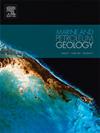Sedimentology and diagenetic evolution of the Upper Permian Khuff Formation in Saudi Arabia. New perspectives from biostratigraphy, U/Pb geochronology and fluid inclusions
IF 3.7
2区 地球科学
Q1 GEOSCIENCES, MULTIDISCIPLINARY
引用次数: 0
Abstract
The Upper Permian section of the Khuff Formation is characterized by mud-dominated facies interpreted as lagoonal to peritidal sediments, interbedded with coated grain, grain-rich deposits suggesting lagoonal to high-energy shoal environments. The diagenetic overprint encompasses early dolomitization, dissolution, and burial diagenetic products such as dolomite cements and at least one phase of anhydrite. For the first time in the Khuff Formation of the Arabian Platform, in-situ LA-ICP-MS chronometry using U/Pb age dating has been performed in one well of the Rub al Khali Basin in order to refine the absolute timing of the various cement phases. The early dolomitization is interpreted as a very early replacive event resulting from hypersaline fluids, but is affected by recrystallization during the Middle Triassic (average 244.3 ± 7 Ma). Dolomite cements include a Guadalupian to base Lopingian phase (D1 – 265.5 ± 8 Ma) and a saddle dolomite (D2) dated from the Lower Jurassic (193.5 ± 15.7Ma). Fluid inclusion measurements in the latter indicate minimal precipitation temperatures of around 150 °C from rather medium salinity fluids, probably related to Lower Jurassic faulting. This study also shows the absence of calcite cements and of thermochemical sulfate reduction (TSR), usually present in the Khuff Formation at the platform-scale. The combined biostratigraphy assessment and U/Pb chronometry performed in this study suggest the section directly overlying the Middle Anhydrite to be slightly older than initially thought, and the transgression on top of the Middle Anhydrite marker extending into the Capitanian. Results also suggest that faults might have been active during the burial history allowing hydrothermal brines to percolate through studied interval.
沙特阿拉伯上二叠统Khuff组沉积学与成岩演化生物地层学、U/Pb年代学和流体包裹体的新视角
Khuff组上二叠统剖面以泥质为主相为特征,为泻湖至潮旁沉积,与包覆颗粒互层,富颗粒沉积提示泻湖至高能浅滩环境。成岩叠印包括早期白云石化、溶蚀和埋藏成岩产物,如白云岩胶结物和至少一相硬石膏。在阿拉伯平台的Khuff组中,首次在Rub al Khali盆地的一口井中使用U/Pb年龄测年技术进行了原位LA-ICP-MS测年,以精确确定各种水泥相的绝对时间。早期白云石化被解释为由高盐流体引起的非常早期的替代事件,但在中三叠世(平均244.3±7 Ma)受到再结晶的影响。白云岩胶结物包括瓜达鲁普期至洛平期基底期(D1 ~ 265.5±8 Ma)和下侏罗统(193.5±15.7Ma)的鞍状白云岩(D2)。后者的流体包裹体测量表明,来自中等盐度流体的最低降水温度约为150°C,可能与下侏罗统断裂有关。该研究还表明,在台地尺度上,Khuff组缺少方解石胶结物和热化学硫酸盐还原(TSR)。综合生物地层学评价和U/Pb年代学结果表明,中硬石膏直接上覆剖面的年龄比最初估计的要稍早,中硬石膏标志物顶部的海侵延伸至Capitanian。研究结果还表明,在埋藏史上,断层可能一直处于活动状态,使热液盐水能够渗透到研究区间。
本文章由计算机程序翻译,如有差异,请以英文原文为准。
求助全文
约1分钟内获得全文
求助全文
来源期刊

Marine and Petroleum Geology
地学-地球科学综合
CiteScore
8.80
自引率
14.30%
发文量
475
审稿时长
63 days
期刊介绍:
Marine and Petroleum Geology is the pre-eminent international forum for the exchange of multidisciplinary concepts, interpretations and techniques for all concerned with marine and petroleum geology in industry, government and academia. Rapid bimonthly publication allows early communications of papers or short communications to the geoscience community.
Marine and Petroleum Geology is essential reading for geologists, geophysicists and explorationists in industry, government and academia working in the following areas: marine geology; basin analysis and evaluation; organic geochemistry; reserve/resource estimation; seismic stratigraphy; thermal models of basic evolution; sedimentary geology; continental margins; geophysical interpretation; structural geology/tectonics; formation evaluation techniques; well logging.
 求助内容:
求助内容: 应助结果提醒方式:
应助结果提醒方式:


